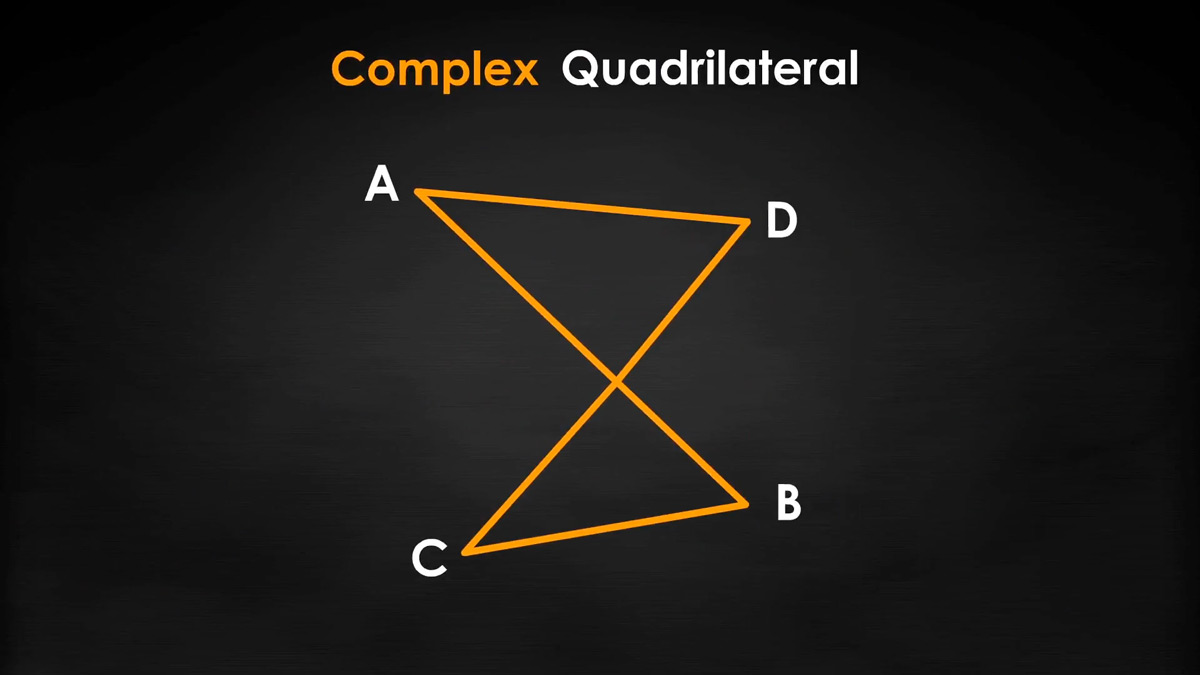What is a Quadrilateral?
Quadrilateral definition
A quadrilateral is a plane figure made with four line segments closing in a space. Quadrilaterals can be convex or concave and simple or complex.
The easiest, fastest way to learn about quadrilaterals is to build one yourself. Find four straight objects to use as line segments (four = quad; side = lateral). If you connect the four linear objects at their eight ends, you have a quadrilateral, a four-sided polygon.
Types of quadrilaterals
Quadrilaterals appear in four different classifications:
Convex – Each interior angle is less than 180° and the two diagonals are inside the closed space of the quadrilateral.
Concave – One interior angle is greater than 180° and one diagonal lies outside the shape.
Simple – The quadrilateral does not cross its sides (it is not self-intersecting).
Complex – The quadrilateral has self-intersecting sides.

Properties of quadrilaterals
A quadrilateral has two identifying properties:
Four straight sides
Four vertices (angles where sides meet at their endpoints)
How many sides does a quadrilateral have?
A quadrilateral has 4 straight sides. Sides and angles can be equal or unequal. When two or four sides are equal, you get special types of quadrilaterals such as trapezoids and rectangles.
Two sides of the quadrilateral can cross each other --a complex quadrilateral -- which makes your quadrilateral look like two adjoining triangles.
Quadrilateral shapes
All the other four-sided plane figures derive from the quadrilateral:

Names of quadrilaterals
Rhombus
Square
Rectangle
Parallelogram
Kite
Dart
Trapezoid
How to draw a quadrilateral
Use a straightedge or ruler to draw a quadrilateral. Draw four line segments so each endpoint touches one other endpoint. Whether you have drawn a simple or complex, convex or concave quadrilateral, you did it correctly!
Draw a simple quadrilateral. Do not let any line segments cross each other. Your simple quadrilateral could be either concave or convex. If two sides point inward, you drew a concave quadrilateral.
Now draw a quadrilateral where two non-adjacent line segments cross each other. You have drawn a complex quadrilateral.
Labeling your quadrilateral
Each vertex is given a letter, moving in either direction (clockwise or counterclockwise) to the next vertex, like quadrilateral ABCD. Each side of the quadrilateral is then identified by its line segment (AB, BC, CD, DA). Each interior angle uses its vertex letter (∠A, ∠B, ∠C, ∠D).

How to name a quadrilateral
A simple quadrilateral is also called a quadrangle or a tetragon. A simple quadrilateral will be symmetrical if it has at least one pair of congruent sides.
The complex quadrilateral has other names, too: butterfly, crossed quadrilateral, self-intersecting quadrilateral, or bow-tie.
Quadrilateral angles
For a simple quadrilateral, interior angles of the four vertices add to 360°.
For a convex quadrilateral, each interior angle will be less than 180°.
For a concave quadrilateral, one interior angle will be greater than 180°.
For a complex quadrilateral, interior angles add to 720° because two of the interior angles are reflex angles, each greater than 180° but less than 360°.

Diagonals of a quadrilateral
All convex quadrilaterals have diagonals (line segments connecting non-adjacent vertices) inside their enclosed space.
All concave quadrilaterals have one of their diagonals outside their enclosed space. All complex quadrilaterals have both diagonals outside their enclosed space.
Complex quadrilaterals
You may have noticed that the complex quadrilateral has self-intersecting sides. In mathematics, though, the angles formed by the intersection are not part of the shape.

A complex quadrilateral has two acute interior acute angles and two interior reflex angles. Those two reflex angles will appear to be outside the shape, which can be confusing. They are still considered "interior" angles.
Even though two line segments cross and appear to make two more interior angles, the quadrilateral is still said to have only four interior angles. The self-intersecting line segments do not add two angles to the complex quadrilateral.
